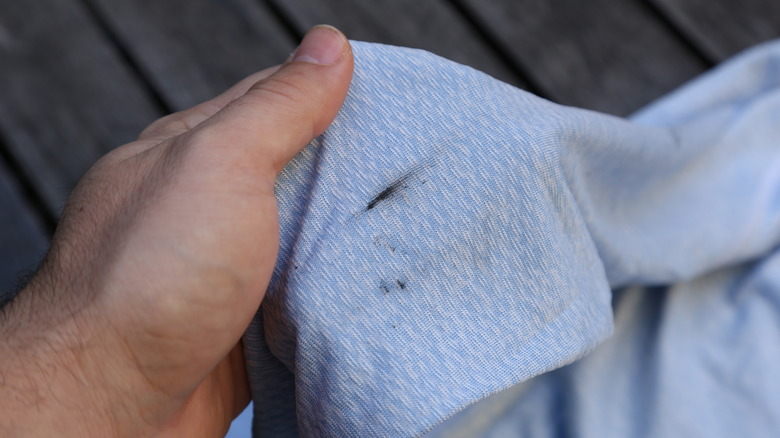Think Twice About Putting Laundry Exposed To These Substances In Your Dryer
Along with washing machines, dryers have made doing laundry a far easier and faster process than it used to be. As useful as this appliance can be though, it isn't the solution for clothes exposed to certain chemicals. Garments that have been doused in flammable substances like gasoline and motor oil or contaminated by pesticides should not be put through the dryer, even after being washed.
Before you can even think about drying clothes that have been exposed to pesticides, grease, or gasoline, you first need to wash them. Unfortunately, garments or rags covered in gasoline or other flammable substances should never be washed in your laundry machine. Instead, allow them to air-dry outside first. Once the moisture is removed, treat the stain with a liquid detergent, or add water to your powdered detergent and use the resulting paste. At this point, you should be able to safely put these items into your washing machine.
You also shouldn't put pesticide-soaked laundry directly into the wash. If your clothes are completely soaked in a full-strength pesticide, it's best to just throw them away. Even if th exposure isn't that severe, you should still wash them separately from other items and with the hottest water possible. Once the garments are properly washed, you need to decide the safest way to dry them.
Dangers of gasoline, oils, and pesticides in the dryer
It might seem like if something has gone through the washing machine, then it's clean and should be safe to put into your dryer, but that isn't necessarily the case. Dryers are quite warm, and the flash point for flammable liquids like gasoline and paint thinner is less than 100 degrees Fahrenheit, and is only slightly higher for combustible fluids like oil and lubricants. Any of these substances could easily start a fire in your dryer if they remain on your laundry.
The risk with pesticides is slightly different. While not all pesticides are flammable, some are. Additionally, they can easily contaminate the inside of your dryer, causing other clothing items in a later load of laundry to be exposed.
How to dry clothes exposed to pesticides, fuels, and oils
If your laundry can't be safely dried in a clothes dryer, then the best option is to air dry it. In the case of pesticide exposure, the sunlight can even help break down any chemicals left on your clothing. If you don't have a clothes line, air-drying alternatives like a collapsible drying rack can work fine. They also have the advantage of being portable, so you can use them either inside or outside depending on the weather, which solves many line-drying problems.
Give your laundry plenty of space to dry. Trying to overload a rack by putting items on top of each other will only cause them to dry slower, as clothes need good airflow to release moisture. Ideally, clothes exposed to pesticides should be air dried for at least 24 hours. If your clothes still have an odor or don't seem fully clean after they are dry, you can always wash them again.


